RON PITTAWAY'S WINTER FINCH FORECAST
2006 - 2007
(Reproduced with author's permission.)
|
|
Note: This page gives the text of Ron Pittaway's informative, educational and always interesting Winter Finch Forecast. He has gathered information regarding conditions in the northern boreal forests and synthesized this to forecast the occurrance of these birds in southern Ontario. There are excellent tidbits about food tree preferences of the various finch species and subspecies, and forest conditions overall. It will help you think globally to find birds locally. Many thanks to Ron for allowing us to offer this report to our visitors. (Photos added by NeilyWorld.)
|
|
Check the Birding Ottawa Past Years' Pittaway's Winter Finch Forecasts pages.
Check the current Birding Ottawa Pittaway Winter Finch Report page.
Check the current Birding Ottawa Winter Specialty Status page.
Check the Birding Ottawa Current Ottawa Winter List.
Return to Birding Ottawa Where and When to See Guide.
Return to Birding Ottawa Table of Contents.
Ron Pittaway's Winter Finch Forecast for 2006 - 2007
GENERAL FORECAST: This is one of those rare years when most conifers (softwoods) and broad-leaved deciduous trees (hardwoods) have synchronized bumper seed crops across much of Eastern Canada and the bordering United States. It will be an excellent winter to see winter finches in northern Ontario and central Ontario (e.g., Algonquin Park). Very few boreal finches will move south of Ontario this fall and winter. Most finches likely will be scarce even in southern Ontario south of the Canadian Shield this winter, despite bumper seed crops on native and ornamental species. There also are bumper cone crops in Quebec, the Maritime Provinces, New York and northern New England States, so finches will be there too, but in what numbers is the question, because excellent crops are so widespread this year. There are good cone crops west of Lake Superior in northwestern Ontario, but cone quality diminishs towards Manitoba because of severe drought conditions this year. Cone crops are generally poor at the continental extremes in Newfoundland and Alaska. Both White-winged and Red Crossbills have been arriving in Ontario since late June in
areas with bumper cone crops. In addition to individual finch forecasts, I also comment on other irruptive species, such as the Red-breasted Nuthatch, whose movements are linked to winter finches. I added a new section this year called Finch Notes. It discusses bumper seed crops, how crossbills find cone crops, when crossbills
move to bumper crops, when crossbills nest, road-killed finches, and where to see finches this winter in Ontario.
INDIVIDUAL FINCH FORECASTS:
PINE GROSBEAK: Most Pine Grosbeaks will stay in northern Ontario because the berry crop on mountain-ash (rowan berries) is excellent to bumper this year. As well, the large seed and berry crops on other trees and shrubs provide ample buffer food supplies to keep the grosbeaks in the north. A few Pine Grosbeaks may drift as far south as Algonquin Park where they are seen most winters.
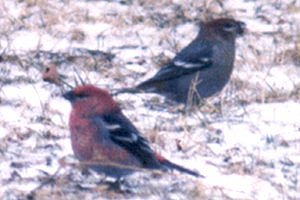 Pine Grosbeaks (Pinicola enucleator)
Pine Grosbeaks (Pinicola enucleator)
PURPLE FINCH: The excellent tree seed crops on most coniferous and deciduous trees suggest that most (not all) Purple Finches will spend this winter in northern and central Ontario. Some may drift south in late winter and show up at feeders, which is typical of this species in big seed years as seed supplies diminish in late winter.
RED CROSSBILL: Taxonomy and nomenclature are hopelessly confused. The Red Crossbill complex comprises at least eight types or forms (possibly full species) with different vocalizations and bill sizes related to cone preferences. Two or three forms are regular in Ontario. One prefers hemlock cones and the others are adapted mostly to pines, mainly white pine in Ontario. Red Crossbills have been seen and heard singing in hemlocks in August suggesting that the small-billed hemlock subspecies 'sitkensis' has moved into central Ontario where hemlock cone crops are excellent as in Algonquin Park and the Haliburton Highlands. The hemlock form has the smallest bill of all Red Crossbills, even smaller than the White-winged Crossbill's stubby bill. Road-killed 'sitkensis' can be identified by measuring
their bills (culmen 13.5-15 mm). White pine cone crops, unlike other conifers, are poor in most of central Ontario such as Algonquin Park. However, some areas of northeastern Ontario have good white pine crops such as Marten River and Timmins. Watch for pine types of Red Crossbills wherever white and red pines have good cone crops. Since spruce cones are so abundant this year, I expect that Red Crossbills will be found feeding in spruce to some extent this winter.
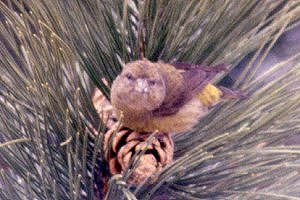 Female Red Crossbill (Loxia curvirostra)
Female Red Crossbill (Loxia curvirostra)
WHITE-WINGED CROSSBILL: Like a pendulum, White-winged Crossbills move back and forth across the northern coniferous forests from Newfoundland to Alaska searching for cone crops. White-winged Crossbills will be widespread and perhaps common in many areas of northern and central Ontario because of the bumper seed crops on spruces, tamarack, balsam fir and hemlock. I expect that the highest concentrations of White-wings will be in northeastern Ontario between Lake Superior and Quebec where the super bumper crop of white spruce cones is "a 1-in-20-year cyclical phenomenon" making this is a rather rare event in seed production for white spruce (Scott McPherson, pers. comm.). White-winged Crossbills began increasing in northern Ontario in late June and increased during July associated with big cone crops. They are singing and feasting on an abundance of cone seeds and probably nesting. They likely will begin nesting again in early 2007. White-winged Crossbills in Algonquin Park have been widespread in small numbers since July and are singing. Nesting is suggested by two sightings of recently fledged young in August. White-winged Crossbills possibly came from western Canada and Alaska wandering eastward searching for cone crops. One reason why there are no subspecies on this continent versus the eight or more types of Red Crossbills is that White-winged Crossbill populations oscillate east and west across North America, and thus are constantly mixing. This allows outcrossing and gene flow among populations, suppressing the formation of geographical variation.
COMMON REDPOLL: This is not a flight year for redpolls in southern Ontario. Most Common and Hoary Redpolls will be in northern Ontario this winter because seed crops on white birch and alder are excellent to bumper there. As well, yellow birch has an excellent crop from southeastern Lake Superior into Quebec. This large crop will stall any redpolls wandering south of the boreal zone. A few redpolls may get as far south as Algonquin Park, but likely no farther.
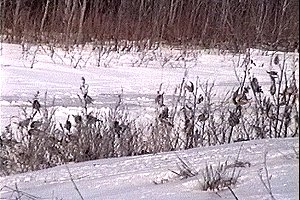 Flock of Common Redpolls (Carduelis flammea)
Flock of Common Redpolls (Carduelis flammea)
PINE SISKIN: Most Pine Siskins will winter in northern and probably central Ontario this winter because cones crops are bumper on spruces, balsam fir, tamarack (larch), cedar and hemlock. Flocks of siskins can be identified at a distance by their distinctive flight formation. They swirl in tight flocks whereas redpolls fly in loose undulating flocks. Siskins should breed early next spring in northern Ontario. Only one subspecies occurs across Canada, indicating that highly nomadic siskin populations mix from coast to coast, inhibiting the formation of geographical variation.
EVENING GROSBEAK: Evening Grosbeaks will stay in the boreal forest this winter because tree seed crops are excellent on conifers and hardwoods such as black ash. Expect a few in Algonquin Park, particularly around the feeders at the Visitor Centre. The eastern
population of Evening Grosbeaks started declining in 1980 as large outbreaks of spruce budworm subsided. The population is probably stable now, but much reduced from the 1970s when Evening Grosbeaks were common at bird feeders.
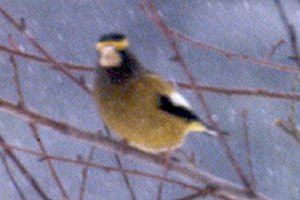 Evening Grosbeak (Coccothraustes vespertinus)
Evening Grosbeak (Coccothraustes vespertinus)
OTHER IRRUPTIVE SPECIES:
BLUE JAY: A small to moderate flight is expected. The good to excellent crop of beechnuts on American beech in most areas of central and southern Ontario should keep most Blue Jays from migrating south this September and October along the shorelines of Lakes Ontario and Erie. Blue Jays are now actively storing beechnuts. Also, there are excellent crops of hazelnuts which will add to the nonmigratory tendency of Blue Jays this fall. The red oak acorn crop is poor in most areas of central Ontario, but the lack of acorns should be compensated for by the large mast crops on other deciduous trees and shrubs.
RED-BREASTED NUTHATCH: Most Red-breasted Nuthatches will not migrate south this fall. The bumper cone crops across Ontario will hold most Red-breasted Nuthatches close to their northern breeding grounds this winter. When Red-breasted Nuthatches winter in the boreal forest they eat conifer seeds so are closely linked to finches.
BOHEMIAN WAXWING: The excellent to bumper crop of mountain-ash (rowan berries) will keep most Bohemians Waxwings close to the boreal forest this winter.
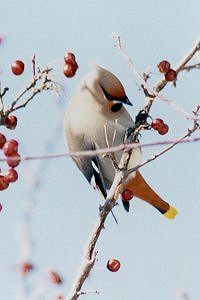 Bohemian Waxwing (Bombycilla garrulus)
Bohemian Waxwing (Bombycilla garrulus)
BOREAL FOREST OWLS: The widespread abundance of seeds, berries, nuts and fruits (mast) is providing a huge food supply for small mammals such as voles so their numbers should be increasing. Most boreal forest owls (Northern Hawk Owl, Great Gray Owl, Boreal Owl) likely will stay close to breeding territories this winter. Increasing numbers of small mammals will increase owl breeding success next spring and summer.
FINCH NOTES:
Why Bumper Tree Seed Crops? One theory of bumper crops is to ensure adequate seed supplies will germinate above the losses to consumers
such as fungi, insects, mammals and birds. Many trees have low seed production in most years followed by periodic bumper crops producing huge surpluses beyond the capacity of seed consumers. Tree species normally synchronize seed crops with members of their own species across hundreds of kilometres/miles and they sometimes synchronize with other species as has happened this year in the Northeast. This year's bumper crops probably resulted from last year's hot and dry stress conditions throughout most of the Northeast. Most plants under stress one year will produce more seed the following year as a form of survival. The size of the seed crop the following year is largely determined by the weather at the time of flowering and pollination. If the weather is too cold or too hot the flower buds will not develop properly. If there is too much rain during pollination and no wind then poor pollination takes place. This year in the Northeast the weather was perfect for most conifer and hardwood species. However, white pine and red oak are two significant species with poor seed crops in 2006 in central Ontario. Why these two species? First, white pine cones take two summers to ripen as opposed to spruce, fir, tamarack, cedar and hemlock which ripen in one summer. Last year white pine grew a drought stressed crop of immature conelets with considerable losses, resulting in a generally poor crop maturing this year. Second, red oak had abundant flowers in May but produced few acorns this year because the weather turned cool and wet just when its flowers were ready to pollinate.
How Do Crossbills Find Bumper Cone Crops? Crossbills (and other finches, particularly siskins) can locate big cone crops half a continent or more away. Crossbills have well-developed sensory and nervous systems and the evidence is clear that they respond to
external stimuli such as growing seed crops. The ability of crossbills to find bumper cone crops suggests something more than random searching, but we do not know how they do it. Ian Newton in his classic 1972 book on "Finches" suggested that crossbills could assess the potential of upcoming cone crops when moving between areas. There is much to learn about nomadic winter finches.
When Do Crossbills Move To Bumper Seed Crops? Before big crossbill nestings, they normally begin arriving in summer in areas with developing bumper cone crops. This summer there were reports of crossbills moving in Minnesota, northern Michigan, northeastern Ontario (both species), central Ontario (both species in Algonquin Park), northern New York State (Red Crossbills), Quebec (White-winged Crossbills), northern New Hampshire (White-winged Crossbills), Maine (White-winged Crossbills) and New Brunswick (White-winged Crossbills). In years when either Red or White-winged Crossbills nested in late winter and early spring in Algonquin Park, numbers were high in the preceding late summer and fall.
When Do Crossbills Nest? The following information is courtesy of Ron Tozer from his draft manuscript for The Birds of Algonquin Park. (A) White-winged Crossbills nest during two main periods in Algonquin Park. (1) The main nestings are in late December to mid-March with fledged juveniles seen from late March to late May. (2) July and August nestings produce young seen in early August to mid-October. (B) Red Crossbills also nest during two main periods. (1) Adults with dependent young have been seen in late April to mid-June from nestings in January, February and probably March. (2) Adults with dependent young seen from mid-August to late October are from nestings in June and probably July. Both species nest occasionally outside the core periods described above. Note: The presence of independent streaked young in either species does not necessarily indicate local breeding because the juvenile plumage can be retained for a considerable time.
Road-killed Finches: This could be a winter when thousands of winter finches are killed by cars in places such as Algonquin Park and the Haliburton Highlands. Finches are attracted to the salt and sand put on highways. They have little fear of cars. I remember one collision that killed 63 siskins in Algonquin Park. Common Ravens have an easy time patrolling for road kills. When you see finches on the road, slow down, flash lights and tap your horn several times. Finches often do not respond in time. Be careful not to confuse other drivers.
Where To See Winter Finches: This will be a good year for a winter trip to Algonquin Park. The park is a three hours drive north of Toronto. White-winged Crossbills and Pine Siskins should be common, although siskins have been absent to date. Red Crossbills, Purple
Finches and Evening Grosbeaks are possible in smaller numbers. A few Pine Grosbeaks are likely, but most will be farther north. Redpolls should stay farther north this winter in the boreal forest. Drive Highway 60 in early morning watching for flocks of finches attracted to the salt and sand put on the highway to reduce accidents. There are feeders at the Visitor Centre, which is open only on weekends in winter. Arrangements can be made to view the feeders on weekdays. For the latest information on finches, call the Visitor Centre at
613-637-2828 or e-mail Ron Tozer (retired park naturalist) at .
ACKNOWLEDGEMENTS: I thank the many birders and staff of the Ontario Ministry of Natural Resources (OMNR) whose composite knowledge and reports allowed me to make reasonable predictions about finches in Ontario this fall and winter. They are Dennis Barry (Durham Region), Shirley Davidson (OMNR Minden), Nancy DeWitt (Alaska), Bruce Di Labio (Eastern Ontario), Shelagh Duckett (OMNR, Thunder Bay), Chris Fagyal (Minnesota), Tyler Hoar (Laurentians, Quebec), Michel Gosselin (Gatineau Hills, Quebec), Charity Hendry (Angus Tree Seed Nursery), Leo Heyens (OMNR Kenora), Brandon Holden (Algonquin Park), Peter Hynard (OMNR Haliburton), Jean Iron (Toronto and Temagami), Bob Knudsen (Ontario Parks, Algoma), Scott McPherson (OMNR Northeast Region), Larry Neily (Ottawa), John Miles (Selkirk Provincial Park, Lake Erie), Brian Naylor (OMNR North Bay) Janet Pineau (Arrowhead Provincial Park), Fred Pinto (OMNR Sudbury), Rick Salmon (OMNR Lake Nipigon), Ron Tozer (Algonquin Park, Marten River, Moosonee), Declan Troy (Alaska), Mike Turner (OMNR Brancroft District), Stan Vasiliauskas (OMNR Northeast Region), Mike Walsh (OMNR Muskoka and Parry Sound) and Matt Young (upstate New York). Matt Young's posts this summer on New York State listservs have been helpful. I am grateful to Ron Tozer for reviewing this post and for information from his draft manuscript for The Birds of Algonquin Park.
RECENT FINCH FORECASTS ARCHIVED: Larry Neily has archived recent finch forecasts in the Birding Ottawa Past Years' Pittaway's Winter Finch Report section.
REFERENCES:
1. Bolgiano, N.C. 2004. Cause and Effect: Changes in Boreal Bird Irruptions in Eastern North America Relative to the 1970s Spruce Budworm Infestation. In 104th Christmas Bird Count 2003-2004 issue. American Birds 58:26-33.
2. Newton, I. 1972. Finches. 288 pages. Collins.
3. Pittaway, R. 1998. Winter Finches. OFO News 16(1):5-7.
Ron Pittaway
8 September 2006
Ontario Field Ornithologists
Minden and Toronto, Ontario
E-mail: jeaniron@sympatico.ca
Check the Birding Ottawa Past Years' Pittaway's Winter Finch Report page.
Check the current Birding Ottawa Pittaway Winter Finch Report page.
Check the current Birding Ottawa Winter Specialty Status page.
Check the Birding Ottawa Current Ottawa Winter List.
Return to Birding Ottawa Where and When to See Guide.
Return to Birding Ottawa Table of Contents.
|




